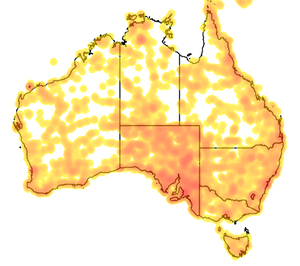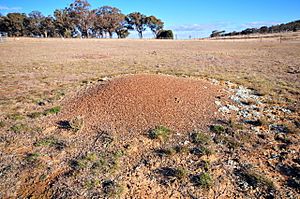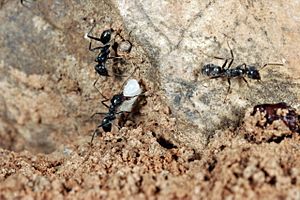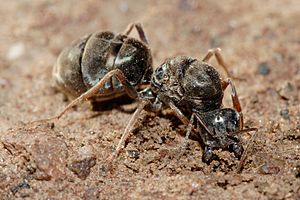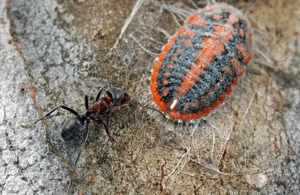Iridomyrmex facts for kids
Quick facts for kids Iridomyrmex |
|
|---|---|
 |
|
| Meat ant (I. purpureus) | |
| Scientific classification | |
| Kingdom: | |
| Phylum: | |
| Class: | |
| Order: | |
| Family: | |
| Subfamily: |
Dolichoderinae
|
| Tribe: |
Leptomyrmecini
|
| Genus: |
Iridomyrmex
Mayr, 1862
|
| Type species | |
| Formica detecta Smith, 1858
|
|
| Diversity | |
| c. 79 extant species 5 fossil species |
|
Iridomyrmex, also known as the rainbow ant, is a group of ants first described in 1862. They get their name from their shiny, blue-green colors, like a rainbow! These ants were named by an Austrian scientist named Gustav Mayr.
There are 79 known types of rainbow ants alive today. Scientists have also found five types that are now extinct, meaning they no longer exist. Most of these ants live in Australia. You can also find them in parts of Asia and Oceania. Some have even traveled to places like Brazil, New Zealand, and the United Arab Emirates.
Rainbow ants are very important in their environments. They are strong and active, but sometimes people see them as pests. This is because they can dig up soil and even come into houses. In rural Australia, farmers sometimes put dead animals on meat ant mounds. The ants quickly eat the animal, leaving only bones in a few weeks.
Some rainbow ants, like the Meat ant (I. purpureus), have special "fights." These fights help them solve arguments over land without hurting each other much. The biggest rainbow ants are about 8 millimeters long.
Contents
What Do Rainbow Ants Look Like?
Rainbow ants have some unique features. Their eyes are on top of their heads, far from their mouths. Unlike some other ants, the front part of their face (called the clypeus) is above their jaws, not below them.
These ants come in different sizes. Some, like the I. conifer group, are about 4 millimeters long and are reddish-brown. The largest ones, like the meat ants, can be up to 8 millimeters long. Most worker ants in this group look very similar to each other.
Sometimes, a rainbow ant worker might be born with a physical difference. For example, one ant was found with its body parts fused together. Even with these differences, the ant could still find food and work almost normally!
Where Do Rainbow Ants Live?
You can find rainbow ants on several continents. In Oceania, they live in places like Fiji, Indonesia, and Papua New Guinea. They are found in every part of Australia. They have also been introduced to both the North and South Islands of New Zealand.
In Asia, they live in countries such as Myanmar, India, and the Philippines. One type, I. anceps, has even been found in the United Arab Emirates in the Middle East. Another species, I. rufoniger, was brought to Brazil by people. We even have fossils of these ants from China, France, and the United States.
Rainbow ants live in many different places. They can be found in dry areas, woodlands, grasslands, and even city parks and gardens. They also live in swamps and wet rainforests.
Most rainbow ants build their nests in the soil. Some prefer to live under rocks or in rotten wood. You might even find them nesting on sandy beaches or footpaths! Their nests look different depending on the species. Some make small mounds with one entrance. Others build large mounds covered in pebbles with many entrances.
Some colonies create huge "super-nests." These are many nests connected by paths that can be as long as 650 meters (about 2,100 feet)! One super-nest covered over 10 hectares of land and had 85 separate nests with 1,500 entrances. Even within the same colony, ants from different nests might act aggressively towards each other.
Some species, like I. conifer, change their nesting spots. In winter, they might build nests in twigs above ground. When it gets warmer, they move back underground. They often choose nest locations where they can get enough sunlight, especially in winter.
Behavior and Daily Life
Many rainbow ant species are quite aggressive. They will attack anything that bothers their nests or their foraging paths. Meat ants, for example, will swarm out of their nests and attack intruders. Even smaller species will bite and spray a special defensive chemical called iridomyrmecin. Because they are so numerous and aggressive, rainbow ants are very powerful in Australia. They often take over food sources and keep other insects away.
However, not all rainbow ants are aggressive. Some are shy and will run and hide if disturbed. If their nest is bothered, these ants will move their young to safety instead of fighting. Some, like I. victorianus, might even stay completely still until the danger passes.
Meat ants have special "ritualized fights" to settle arguments over their territory with nearby colonies. When ants from different colonies meet, they might "fight" by touching antennae and opening their jaws wide. They also stretch themselves to look bigger. These fights rarely cause serious injury or death and can go on for months or even years.
Finding Food
All rainbow ants are both hunters and scavengers. They look for small insects to eat and collect nectar from flowers. They also "farm" tiny insects like aphids and caterpillars. These insects give the ants a sweet liquid called honeydew.
Rainbow ants usually look for food on the ground. But many species also climb trees and plants to find food. Most are active during the day. Some are active at night, but they might come out during the day if the weather is right. Some nocturnal ants even block their nest entrances during the day. However, I. bigi is always nocturnal.
What Do Rainbow Ants Eat?
Rainbow ants love sweet foods like nectar and honeydew. They also hunt insects and other ants to feed their young. They are attracted to seeds that have a fatty part called an elaiosome. The ants take these seeds, remove the elaiosome, and then throw the seed away. This helps the plants grow, as the seedlings are protected by the aggressive ants.
Sometimes, rainbow ant colonies build their nests inside termite mounds. This means they often eat termites. Some species, like I. purpureus, can even eat young cane toads because they are immune to the toad's poisons. Farmers have even thought about using these ants to help control cane toad populations. Meat ants are also the only known ants in Australia that eat guano (bat or bird droppings).
Who Eats Rainbow Ants?
Many animals prey on rainbow ants. A spider called Habronestes bradleyi specifically hunts these ants. It can even use the ants' alarm signals to find them! The thorny devil lizard in Australia mostly eats Iridomyrmex ants. It will pick and choose which species it eats. A type of blind snake called Ramphotyphlops nigrescens follows ant trails to find them and eat their young. Ground beetles also dig tunnels near ant nests to catch passing workers.
The short-beaked echidna is a major predator. It especially likes to eat the young queen ants when they are flying to find mates. This is because the queens are full of fat. Echidnas usually hunt ants between August and October, when the winged males and females (called alates) leave their nests. Birds like currawongs and magpies also dig up new ant nests to eat the queens.
Life Cycle and Reproduction
Rainbow ants have their mating flights throughout the year in warm, humid places. During this time, winged male and female ants (alates) fly out of the nest. They climb onto tall things like trees or fences to mate. Some queens mate with one male, while others mate with several.
After mating, the males die. The queens then search for a good place to start a new colony. This is a dangerous time for queens, as birds and other ants might eat them. They can also die from disease or starvation. Most queens start a nest by themselves. But sometimes, several queens work together to start a colony. Or, a group of ants, including queens, workers, and young ants (eggs, larvae, and pupae), might leave an old colony to start a new one.
Once a queen digs a small chamber, she lays about 20 eggs. These eggs take about 44 to 61 days to grow into adult ants. Mature nests can have anywhere from a few hundred ants to over 300,000 workers!
Most colonies have only one queen. But some can have up to four queens. In colonies with multiple queens, the workers treat all the queens equally. However, the queens themselves might not get along. Queens tend to care only for their own young and ignore the young of other queens. Once the colony grows big enough, the queens will often separate from each other.
Working Together: Symbiotic Relationships
Rainbow ants have special partnerships, called symbiotic relationships, with many caterpillars, aphids, and scale insects. The ants protect these insects. In return, the insects give the ants sweet honeydew. Sometimes, the ants even bring the caterpillars into their nests for protection.
Many types of butterflies also have these relationships with Iridomyrmex ants. For example, workers attend to caterpillars of butterflies in the Jalmenus and Ogyris groups. One species, I. bicknelli, even helps pollinate orchids. This means they help the orchids make seeds, and the orchid pollen isn't harmed by the ants.
Meat ants have been seen blocking the holes of banded sugar ant nests with pebbles and soil. This stops the sugar ants from leaving their nests early in the morning. The sugar ants fight back by blocking the meat ants' nests with debris! If a meat ant nest gets too much shade from trees, banded sugar ants might even take over the nest. The meat ants then move to a new nest in a sunnier spot.
Rainbow Ants and Humans
In rural Australia, meat ants are helpful to farmers. They can quickly clean up dead animal carcasses, leaving only bones. However, Iridomyrmex ants can also be seen as pests. They might come into houses looking for food or disturb gardens by digging. Getting rid of their nests can be hard because other ants from nearby nests might move in.
Some rainbow ant species have adapted well to living near people. In places like Canberra, new neighborhoods provided many new nesting spots for meat ants, helping their populations grow. Home gardens and planted areas also give them good food sources. But for citrus fruit growers, these ants can be a problem. They might interfere with insects that help control pests on citrus trees.
See also
 In Spanish: Iridomyrmex para niños
In Spanish: Iridomyrmex para niños


